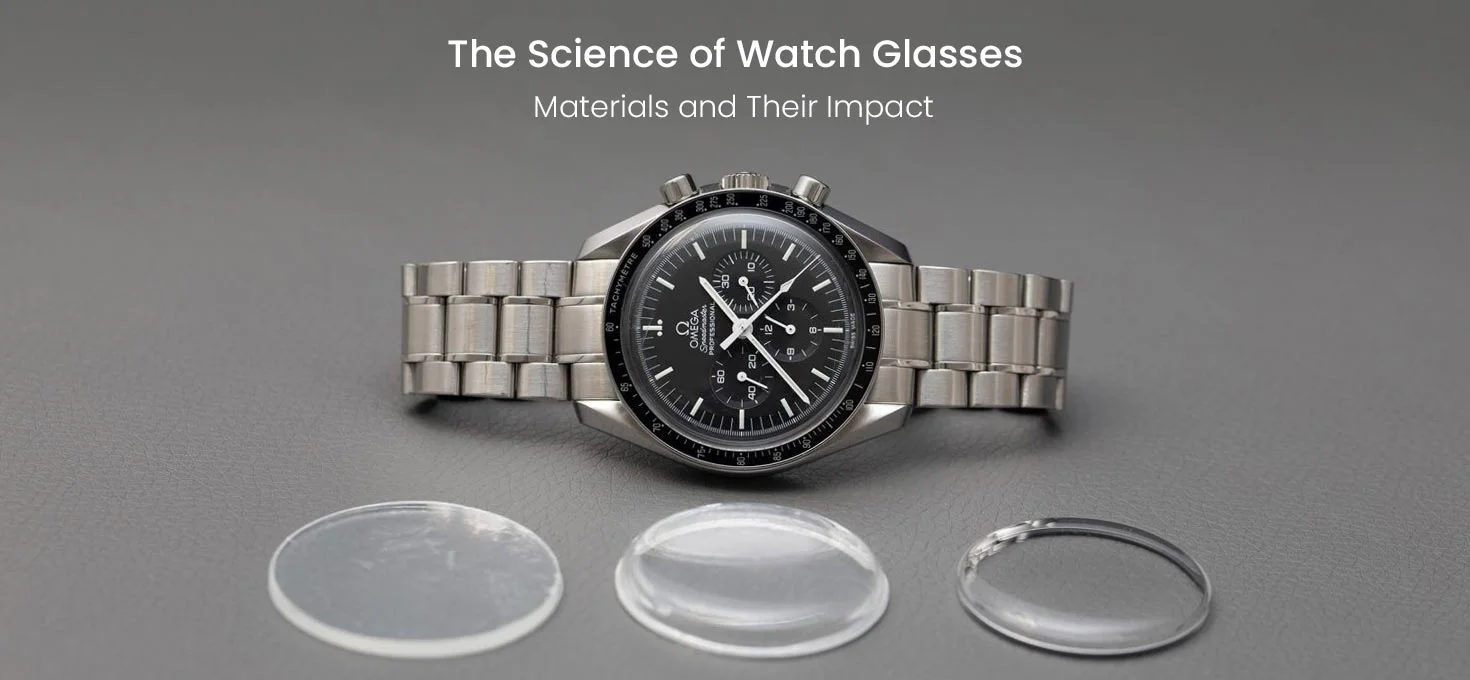 Reading Time: 6 minutes
Reading Time: 6 minutes
Have you ever wondered what separates a luxury watch from a budget timepiece? One crucial factor is the types of wrist watch glasses used, the transparent covering that protects the dial and adds to its overall aesthetic. Beyond its protective function, the wrist watch glasses play a significant role in determining the watch’s durability, clarity, and even its style. Choosing the right types of watch glass can significantly impact your experience, whether you’re a casual wearer or a serious collector.
In this blog post, we’ll delve into the world of watch glasses, exploring the different types of watch glass available and the materials used to craft them. From the iconic sapphire crystal to the more affordable mineral glass, we’ll discuss the pros and cons of each option and help you choose the perfect watch glass for your needs.
Types of Glasses Used in the Making of Watch:
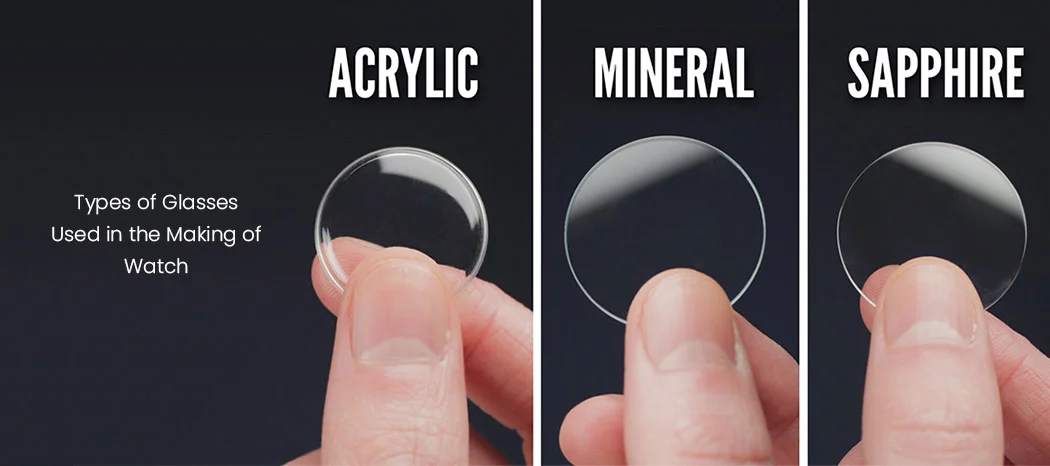
Wrist watch glasses come in a variety of materials, each with its own unique properties. Mineral glass is the most common option, offering good scratch resistance but being more susceptible to shattering. Sapphire crystal, on the other hand, is renowned for its exceptional hardness and clarity, making it a popular choice for high-end watches. Acrylic glass, while less scratch-resistant, is known for its shock resistance and is often found in vintage watches. Other materials like ceramic and plastic offer distinct characteristics, catering to different preferences and needs.
Acrylic Watch Glass: A Vintage Choice for Watch Glass
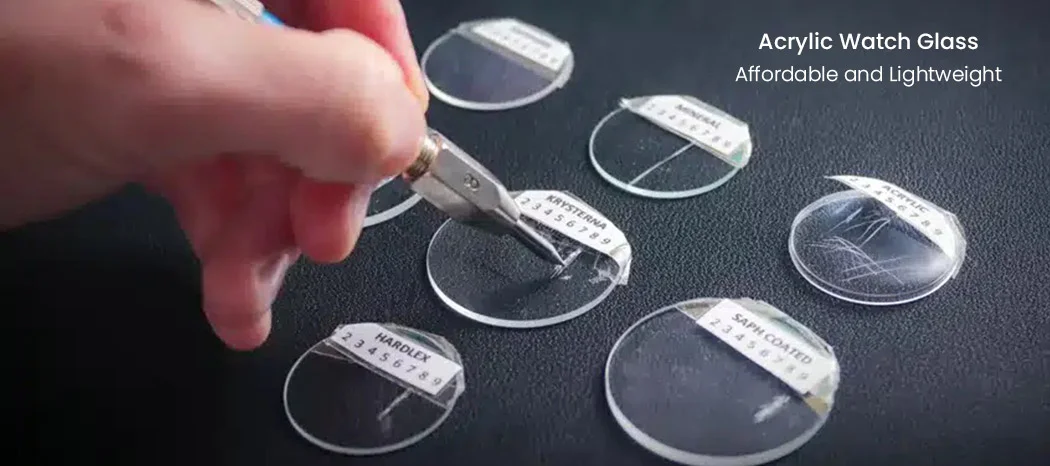
Acrylic wrist watch glasses or plexi glass or lucite, a type of plastic, has been used in watches for many years, particularly in vintage timepieces. While not as durable as mineral glass or sapphire crystal, acrylic offers unique characteristics that have made it a popular choice in certain applications. Acrylic glass, the most affordable of the three main types of watch glass, was commonly used until the 1980s. This plastic material is flexible, clear, and lightweight. It’s difficult to shatter but can be scratched easily.
Uses:
- Vintage Watches: Acrylic glass is commonly found in vintage watches, adding to their nostalgic appeal.
- Budget Watches: Due to its lower cost compared to other materials, acrylic glass is sometimes used in budget-friendly watches.
- Sports Watches: In some cases, acrylic glass is used in sports watches due to its shock resistance.
Pros:
- Affordability: Acrylic glass is one of the most affordable watch glass materials.
- Shock Resistance: It offers better shock resistance than glass, making it suitable for watches exposed to impacts.
- Flexibility: Acrylic glass is more flexible than glass, which can reduce the risk of shattering.
Cons:
- Scratch Susceptibility: Acrylic glass is more prone to scratches than glass or sapphire crystal.
- Yellowing: Over time, acrylic glass can develop a yellowish tint, affecting its appearance.
- Lower Clarity: Acrylic glass may not offer the same level of clarity as glass or sapphire crystal.
While acrylic glass has been used in watches for many years, its popularity has declined in recent decades due to the availability of more durable and scratch-resistant materials. However, for those seeking a vintage aesthetic or a budget-friendly option, acrylic glass can still be a viable choice.
Mineral Watch Glass: Timeless Choice for Watches
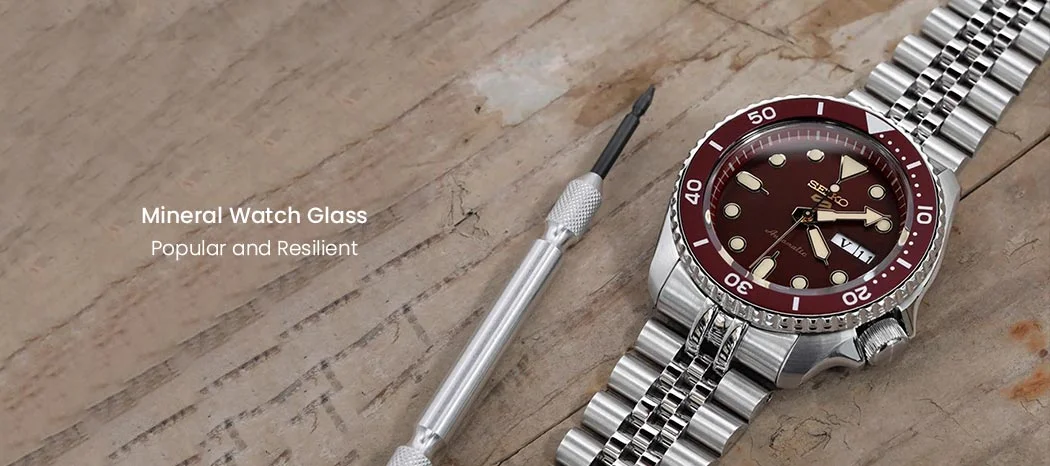
Mineral glass is a ubiquitous material in the watch industry, serving as the protective covering for countless timepieces. Mineral glass is the most widely available watch glass option. It’s moderately hard, used in windows, and is made stronger by heating and adding a protective coating. This process makes it more resistant to scratches and breaks compared to acrylic glass. The use of glass in watches dates back to the early 19th century. However, the development of mineral glass as a specific material for watch faces is more recent. Mineral glass is essentially a type of tempered glass, a process that enhances its strength and resistance to breakage.
Mineral glass is widely used in watches across various price ranges and styles. It’s a common choice for entry-level and mid-range watches due to its affordability. Mineral glass is also suitable for watches designed for everyday wear, as it offers a balance between durability and cost-effectiveness.
Pros:
- Affordability: Mineral glass is generally more affordable than other watch glass materials like sapphire crystal.
- Durability: Tempered mineral glass is relatively resistant to scratches and impacts, making it suitable for everyday use.
- Clarity: Mineral glass provides good clarity and transparency, allowing for easy viewing of the watch dial.
- Versatility: Mineral glass can be used in various watch designs, from classic to modern.
Cons:
- Susceptibility to Scratches: Compared to sapphire crystal, mineral glass is more prone to scratches over time.
- Shatter Risk: While tempered, mineral glass can still shatter if subjected to severe impacts.
- Mineral glass’s popularity can be attributed to its combination of affordability and durability. It offers a practical and reliable choice for many watch enthusiasts, especially those who prioritize value and function over the ultimate in scratch resistance. While sapphire crystal may be preferred for its exceptional hardness, mineral glass remains a popular and viable option for a wide range of watches.
Sapphire Watch Glass: The Pinnacle of Watch Glass Materials
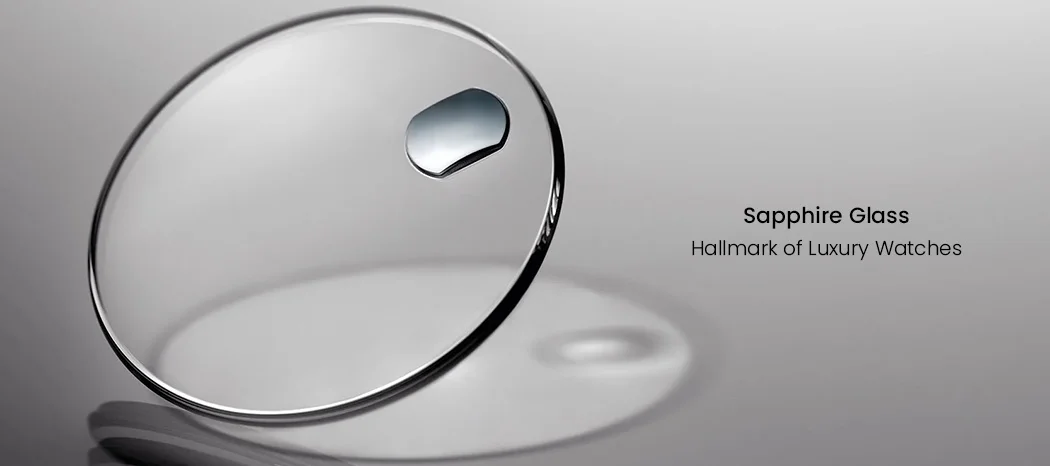
Sapphire glass is considered the pinnacle in types of watch glass materials, renowned for its exceptional hardness, clarity, and durability. Its superior properties have made it a popular choice for high-end watches and luxury timepieces. Sapphire glass, a synthetic crystalline form of aluminum oxide, the first recorded use of sapphire crystal in watches was in the 19th century. Its initial applications were limited to military and aviation watches due to its high cost and specialized manufacturing processes.
Uses:
- Luxury Watches: Sapphire glass is a hallmark of luxury watches, symbolizing quality and prestige.
- High-End Sports Watches: Its durability and scratch resistance make it ideal for sports watches that are subjected to rigorous conditions.
- Diver’s Watches: Sapphire glass’s resistance to pressure and its clarity are essential for diver’s watches.
Pros:
- Exceptional Hardness: Sapphire glass is one of the hardest materials known, making it virtually scratch-resistant.
- Superior Clarity: It offers excellent clarity and transparency, ensuring optimal legibility of the watch dial.
- Durability: Sapphire glass is highly resistant to impacts and pressure, making it suitable for various environments.
- Anti-Reflective Coatings: Sapphire glass can be treated with anti-reflective coatings to minimize glare and enhance visibility.
Cons:
- Cost: Sapphire glass is generally more expensive than other watch glass materials.
- Manufacturing Complexity: The production of sapphire glass requires specialized equipment and techniques, contributing to its higher cost.
- Sapphire glass’s combination of hardness, clarity, and durability makes it a highly sought-after material for watches. Its superior properties not only enhance the watch’s functionality but also elevate its aesthetic appeal. While its higher cost may be a deterrent for some, sapphire glass is often seen as an investment in a timepiece that will last for generations.
How to make the best choice?
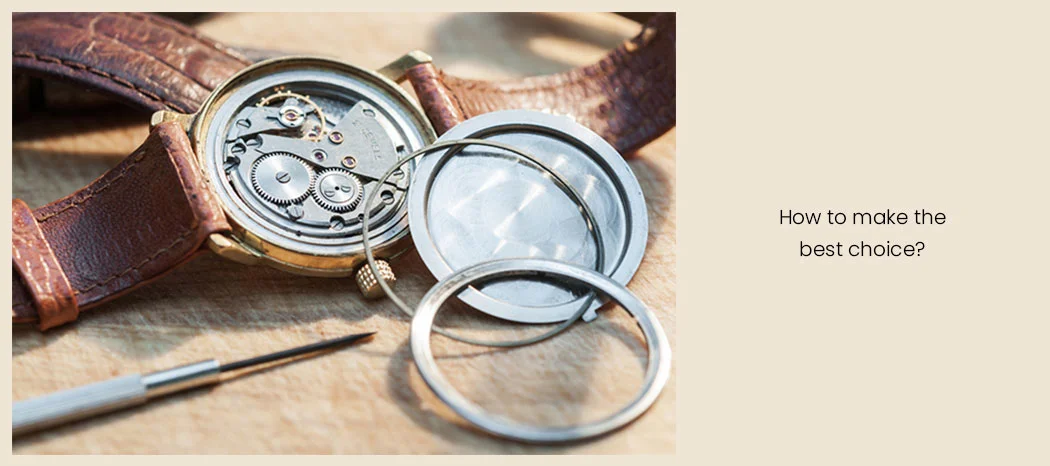
To sum everything up, Acrylic glass, while budget-friendly and shock-resistant, is susceptible to scratches and may yellow over time. It is often found in vintage watches and lower-end models. Mineral glass, a popular choice for its balance of affordability and durability, is commonly used in mid-range watches. It offers decent scratch resistance but may shatter under extreme impact.
Sapphire crystal, the most coveted material, stands out for its exceptional hardness, clarity, and durability. Its resistance to scratches and impacts makes it ideal for luxury watches and those subjected to rigorous conditions. However, its higher cost may be a deterrent for some.
When choosing a watch glass, consider your budget, lifestyle, and desired level of durability. For those seeking a balance of affordability and durability, mineral glass is a solid option. If you prioritize scratch resistance and clarity, sapphire crystal is the way to go. Acrylic glass can be a suitable choice for vintage enthusiasts or those on a tight budget.
Ultimately, the best watch glass for you depends on your individual preferences and needs. By understanding the characteristics of each material, you can make an informed decision and select a timepiece that not only looks great but also stands the test of time.
KAPOOR WATCH COMPANY:
Kapoor Watch Company, a prominent Indian retailer, has established itself as a go-to destination for luxury timepieces and accessories. With a global presence and a reputation for excellence, Kapoor Watch Company offers a curated collection of renowned brands, including Bvlgari, Cartier, Chopard, and Montblanc. Our extensive catalog showcases a diverse range of timepieces, jewelry, and accessories, catering to discerning individuals with a passion for luxury. Differentiating between various watch glass types can be confusing, but our trained professionals and experts are there to help you. They are always eager to clear any doubts you might have about watches, glasses or any other features. From elegant watches to exquisite jewelry, Kapoor Watch Company provides a luxurious shopping experience, ensuring that every customer finds their perfect piece. Visit Kapoor Watch Co. website OR Visit Kapoor Watch Co. Stores to check out the collection.
The post The Science of Watch Glasses: Materials and Their Impact appeared first on Kapoor Watch Co. | Blogs.





